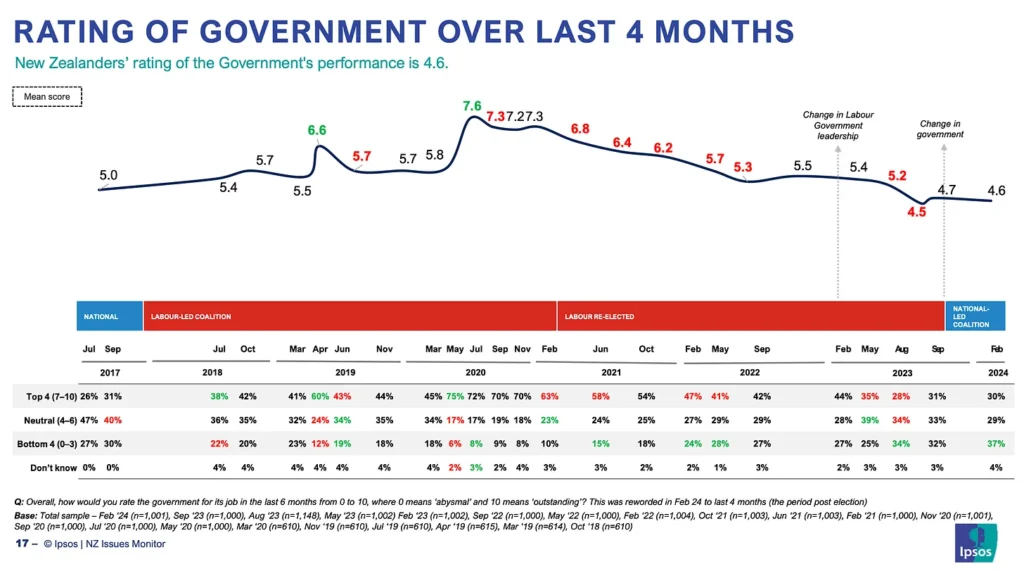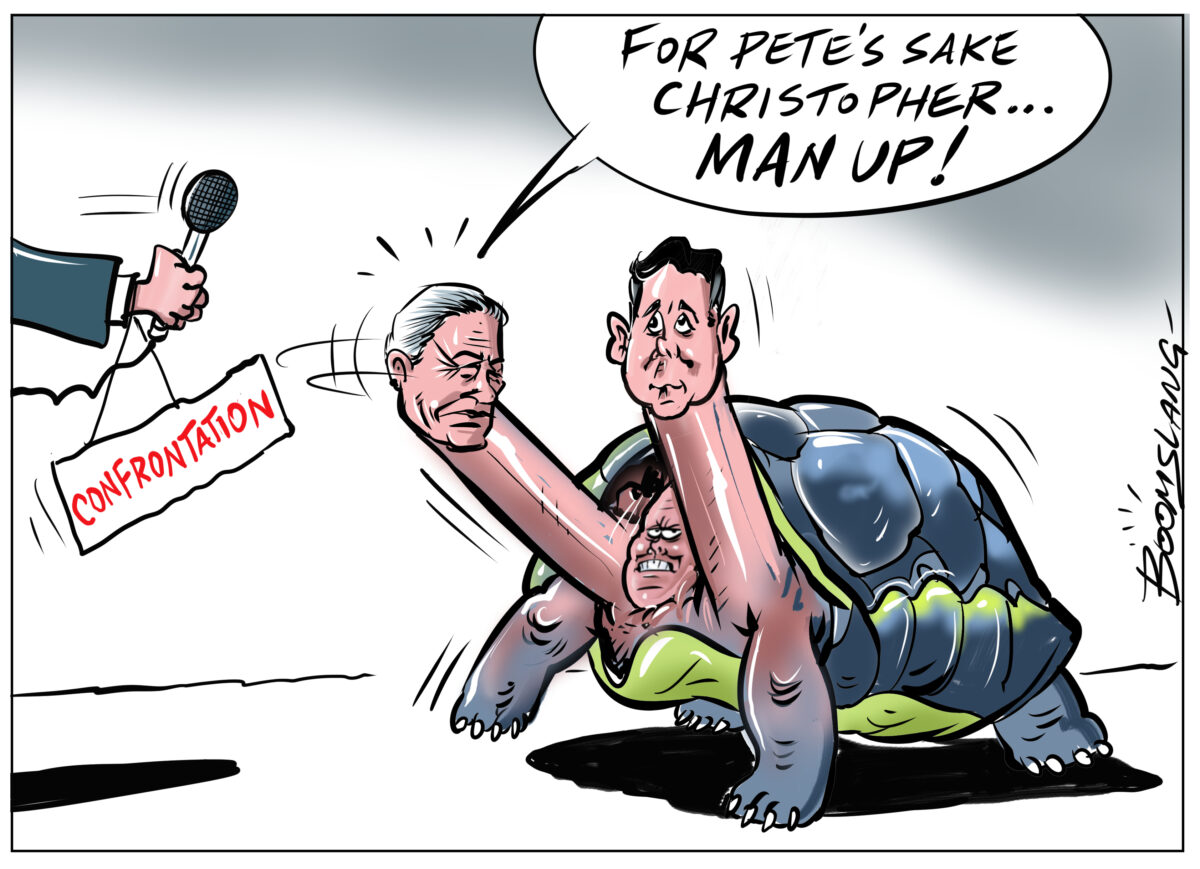Bryce Edwards
Political Analyst in Residence, Director of the Democracy Project, School of Government, Victoria University of Wellington
It’s been a tumultuous time in politics in recent months, as the new National-led Government has driven through its “First 100 Day programme”. During this period there’s been a handful of opinion polls, which overall just show a minimal amount of flux in public support for the various parties in Parliament – the levels of support for each party are roughly where they were at the last election.
Yet beneath the steady “party vote” numbers are some further polling results that should worry the new National-led administration. It appears that Christopher Luxon’s Government is not receiving the usual “honeymoon” period normally gifted to the fresh faces controlling the Beehive.
The IPSOS poll for February
The most concerning survey result for the Government comes today from the IPSOS polling company, which released its latest “Issues Monitor” report, showing that New Zealanders rate the performance of the new Government at only 4.6 out of 10. You can see the full report here: IPSOS: 23rd Ipsos NZ Issues Monitor Feb 2024
The polling company asked 1000 New Zealanders: “Overall, how would you rate the government for its job in the last 6 months from 0 to 10, where 0 means ‘abysmal’ and 10 means ‘outstanding’?” The 4.6/10 result is the mean average answer.
IPSOS reports that this poor score is very similar to the lows recorded for the last government. The Labour Government received its highest score of 7.6 in July 2020, but by August 2023 it had dropped to 4.5. You can see the changing scores for the various governments, since 2017, in the chart below from the IPSOS report:

What is also interesting is to look at the breakdown of the proportions that gave the Government a high score (7-10/10), a mid-score (4-6/10) or a low score (0-3/10). In the latest survey, 37 per cent of respondents gave a low score, which was the highest proportion since the survey began in July 2017, and the report authors label a “significant” increase. Meanwhile, 30 per cent gave a high score, and 29 per cent gave a mid-score. This suggests a rather polarised electorate.
Political scientist Grant Duncan comments today on the latest result: “We’d normally expect a ‘honeymoon’ boost in a new government’s rating, if only due to people feeling glad about a change. But the Luxon government was mired in controversy even before the coalition agreements were drafted” – see: It’s official: Luxon missed out on a honeymoon
Duncan suggests that the latest poor score might be a result of the Treaty and ethnicity debates of February: “The IPSOS poll was run in late February, after the country had gone through a lot of debate and angst, thanks to ACT’s proposed Treaty bill and to controversial policies such as the disestablishment of the Maori Health Authority”.
Luxon responded to the latest poll today on TVNZ’s Breakfast by saying he was “not too hung up on polls” and he pointed out that “for 15 of the 20 areas of concern raised by New Zealanders in the study, respondents backed the National Party’s ability to deal with them” – see Felix Desmarais’ No honeymoon: Govt performance 4.6 out of 10 so far – poll
The IPSOS survey also showed the following top five issues of concern for the public:
- Inflation / cost of living 59% (-3)
- = Housing / price of housing 33% (+2)
- = Healthcare / hospitals 33% (+1)
- Crime / law and order 27% (-10)
- The economy 25% (+1)
The Talbot Mills poll
Yesterday, the latest Talbot Mills poll result was published by BusinessDesk, showing the following party vote support:
- National: 38% (-)
- Labour: 28% (-1)
- Greens: 14% (+2)
- Act: 8% (+1)
- NZF: 6% (-1)
More concerning for the Government was the “preferred PM” result, which had Christopher Luxon on 24 per cent (down 3 points), and only slightly above Chris Hipkins, on 23 per cent. The last National prime minister to perform this poorly was Jenny Shipley, who polled only 22 per cent 26 years ago in 1998 – one year before National lost the election to Helen Clark’s Labour Party.
The mood of the electorate has also soured. When asked if the country is headed in the right or wrong direction, 48 per cent said it was on the “wrong track”, which was up seven percentage points since February. Those who said New Zealand on the “right track” was down three points to only 40 per cent.
This poll was apparently carried out for Talbot Mills’ corporate clients, and wasn’t meant for publication, but you can read about it in Pattrick Smellie’s article, Christopher Luxon struggling to connect: leaked poll (paywalled)
Smellie also reports that “more than two-thirds of those polled named the cost of living as one of their three biggest concerns. That dwarfed the next three worries: health, crime and housing, which were all nominated roughly equally”. Furthermore, “almost three-quarters of voters opposed ‘semi-automatic weapons being made legal again’, at 73%.”
The Taxpayers Union Curia poll
Eleven days ago the Taxpayers Union Curia Poll also came out, which showed some broadly similar results. The Herald’s Thomas Coughlan reported on it: “The mood of the country appears to have soured on the Government. After a couple of months in which more Kiwis felt the country was on the ‘right track’, the right track-wrong track indicator tipped into negatives again, with net 3 per cent of people thinking NZ was on the wrong track. More people disapprove of the Government than approve of it. A net 3.9 per cent of people disapprove of the Government, a shift of 8.4 points on last month’s poll” – see: Latest poll: Christopher Luxon’s popularity crashes after allowance blunder, now trails Chris Hipkins
Also, in terms of Luxon’s favourability, the results were bad news. His net favourability had dropped 16 points to -5 per cent, behind that of Hipkins on +2 per cent. However, the other party leaders in government fared much better, with David Seymour up 6 points to -8 per cent and Winston Peters up 10 points to -22 per cent.
Thomas Coughlan points out that the Curia poll had been carried out at the time that Luxon had endured very negative media coverage over his accommodation entitlement.
Here are the party vote figures:
- National: 37.4% (-2.2)
- Labour: 25.3% (-2.6)
- Greens: 11.3% (+2.3)
- Act: 10% (-3.7)
- NZF: 7.4% (-+2.4)
- TPM: 2.5% (+0.2)
Also in March, the Roy Morgan poll – which receives less media publicity, due to this Australian company not belonging to the New Zealand agreement on survey methodology – also had broadly similar results, albeit with Labour on even lower figure:
- National: 35.5% (-2.5)
- Labour: 21.5% (-0.5)
- Greens: 15.5% (-)
- Act: 12% (+4.5)
- NZF: 7% (+1.5)
- TPM: 4% (-0.5)
- TOP: 2.5% (-2)
The lack of a honeymoon for the new prime minister was also discussed last month by 1News’ Justin Hu, who has looked at what happened when Helen Clark, John Key and Jacinda Ardern became PM: “Back in 2000, Helen Clark enjoyed a 13-point bump in preferred prime minister polling… Nine years later, following Clark’s defeat, successor John Key rose in support from 40% to 51% as preferred prime minister in the February following the 2008 election… Following the swearing-in of Jacinda Ardern’s 2017 coalition government, she also posted a 10-point lift in her preferred prime minister numbers by the following February” – see: Luxon’s popularity low compared to other first-term PMs
Political scientist Lara Greaves is reported in this article as putting the problem for Luxon mostly down to Winston Peters and David Seymour occupying much of the spotlight since the coalition was formed. She says that having “two very strong deputy prime ministers with quite strong personalities” was affecting the public’s perception of Luxon.
Since then, both Peters and Seymour have only made their presence even stronger and their controversies bigger. It’s hard to see how any of this is going to help Luxon push up his government’s report card above 4.6/10.

